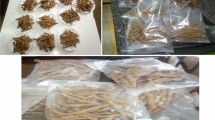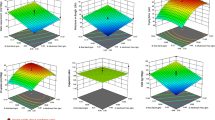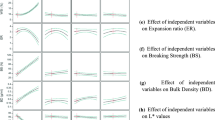Abstract
The aim of the experiment was to optimize barrel temperature (122 to 178 ± 0.5 °C) and red kidney bean flour percentage (KBF) (12 to 68 ± 0.5 %) based on physical properties of extrudates like flash off percentage, water absorption index (WAI), water solubility index (WSI), bulk density (BD), radial expansion ratio (RER) and overall acceptability (OAA) using single screw extruder. The study was carried out by central composite rotatable design (CCRD) using Response surface methodology (RSM) and moisture content of feed was kept as constant 16.0 ± 0.5 % throughout experiments. Mathematical models for various responses were found to fit significantly (P < 0.05) for prediction. Optimization of experimental conditions was carried out using numerical optimization technique and the optimum barrel temperature and kidney bean flour percentage were 120 °C (T1) & 142.62 °C (T2 = T3) and 20 % respectively with desirability value of 0.909. Experiments were carried out using predicted values and verified using t-test and coefficient of variation percentage. Extruded snack prepared with rice flour (80 %) and kidney bean flour (20 %) at optimized conditions was accepted by the taste panellists and above 20 % KB incorporation was found to decrease overall acceptability score.







Similar content being viewed by others
References
Azevedo A, Gomes JC, Stringheta PC, Gontijo AMC, Padovani CR, Riberio LRZ (2003) Black bean (Phaseolus vulgaris L.) as a protective agent against DNA damage in mice. Food Chem Toxicol 41:1671–1676
Batistuti JP, Barros RMC, Arêas JAG (1991) Optimization of extrusion cooking process for chickpea (CicerArietinum L.) deffatted flour by response surface methodology. J Food Sci 56:1695–1698
Beninger CW, Hosfield GI (2003) Antioxidant activity of extracts, condensed tannin fractions and pure flavonoids from Phaseolus vulgaris L. seed coat colour genotypes. J Agric Food Chem 51:7879–7883. doi:10.1021/jf0304324
Bhattacharya S, Prakash M (1990) Extrusion of blends of rice and chick pea flour: a response surface analysis. J Food Eng 21:315–330
Claver IP, Zhang H, Li Q, Kexue Z, Zhou H (2010) Optimization of ultrasonic extraction of polysaccharides from Chinese malted sorghum using response surface methodology. Pak J Nutr 9(4):336–342
Dansby MY, Bovell-Benjamin AC (2003) Physical properties and sixth graders’ acceptance of an extruded ready-to-eat sweet potato breakfast cereal. J Food Sci 68:2607–2612. doi:10.1111/j.1365-2621.2003.tb07069.x
Gutkoski LC, El-Dash AA (1999) Effect of extrusion process variables on physical and chemical properties of extruded oat products. Plant Foods Hum Nutr 54:315–325. doi:10.1023/A:1008101209353
Harper JM (1981) Extrusion of foods (Vol. 1). CRC Press Inc, Boca Raton
Jones J, Lineback D, Levine M (2006) Dietary reference intakes: implications for fibre labelling and consumption: a summary of the international life sciences institute north american fibre workshop, June 1–2, 2004. Nutr Rev 64:31–38. doi:10.1111/j.1753-4887.2006.tb00170.x
Jorge M-C, Alvaro M-R, Roberto G-D, Xiomara P-S, Cuauhtémoc R-M (2012) Optimization of extrusion process for producing high antioxidant instant amaranth (Amaranthus hypochondriacus L.) flour using response surface methodology. App Maths 3:1516–1525
Kaur M, Singh N (2006) Relationships between selected properties of seeds, flours and starches from different chickpea cultivars. Int J Food Prop 9:597–608. doi:10.1080/10942910600853774
Kumagai H, Byeong-Heon L, Toshimasa Y (1987) Flour treatment to improve the quality of extrusion-cooked rice flour products. Agric Biol Chem 51:2067–2071. doi:10.1271/bbb1961.51.2067
Larmond E (1977) Laboratory methods for sensory evaluation of foods. Dept. of Agric Ottawa 1637, Canada
Liu Y, Hsieh F, Heymann H, Huff HE (2000) Effect of process conditions on the physical and sensory properties of extruded oat-corn puff. J Food Sci 65:1253–1259. doi:10.1111/j.1365-2621.2000.tb10274.x
Lue S, Hsieh F, Huff HE (1991) Extrusion cooking of corn meal and sugar beet fiber: effects on expansion properties, starch gelatinization and dietary fiber content. Cereal Chem 68(3):227–234
Madhujith T, Shahidi F (2005) Antioxidant potential of pea beans (Phaseolus vulgaris L.). J Food Sci 70:585–590. doi:10.1111/j.1365-2621.2005.tb09071.x
Morrow B (1991) The rebirth of legumes: legume production, consumption and export are increasing as more people become aware of legumes nutritional benefits. Food Technol 45:96–121
Myers RH, Montgomery DC (2002) Response surface methodology process and product optimization using designed experiments, 2nd edn. Wiley, New York
Onwulata CI, Konstance RP, Smith PW, Holsinger VH (2001) Co-extrusion of dietary fiber and milk proteins in expanded corn products. LWT–food. Sci Technol 34:424–429
Perez-Navarrete C, Gonzáles R, Chel-Guerrero L, Betancur-Ancona D (2006) Effect of extrusion on nutritional quality of maize and Lima bean flour blends. J Sci Food and Agric 86:2477–2484. doi:10.1002/jsfa.2661
Pomeranz Y (1970) Protein enriched bread. Crit Rev Food Sci Nutr 1:453–478. doi:10.1080/104083970095271 08
Prachi G, Premavalli KS (2012) Development of radish fibre based snack by response surface methodology. J Food Sci Technol 49(1):58–65. doi:10.1007/S13197-011-0261-z
Rampersad R, Badrie N, Comissiong E (2003) Physico-chemical and sensory characteristics of flavoured snacks from extruded cassava/pigeonpea flour. J Food Sci 68:363–367. doi:10.1111/j.1365-2621.2003.tb14166.x
Ruiz-Ruiz J, Martinez-Ayala A, Drago S, Gonz’alez R, Batancur-Ancona D, Chel-Guerrero L (2008) Extrusion of a hard-to-cook bean (Phaseolus vulgaris L.) and quality protein maize (Zea mays L.) flour blend. LWT Food Sci Technol 41:1799–1807. doi:10.1016/j.lwt.2008.01.005
Sefa–Dedeh S, Cornelius B, Sakyi–Dawson E, Afoakwa EO (2003) Application of response surface methodology for studying the quality characteristics of cowpea–fortified nixtamalized maize. Innov Food Sci Emer Technol 4:109–119
Snedecor GW, Cochran WG (1967) Statistical methods. Iowa State University Press, Ames
Tharanathan RN, Mahadevamma S (2003) A review: grain legumes a boon to human nutrition. Trends Food Sci Technol 14:507–518
Vargas-López JM, Paredes-Lopez O, Espitia E (1990) Evaluation of lime heat treatment on physicochemical properties of amaranth flour by response surface methodology. Cereal Chem 67(5):417–421
Vatsala CN, Sexana DC, Rao PH (2001) Optimization of ingredients and process conditions for the preparation of pair using response surface methodology. Int J Food Sci Technol 36:407–414
Veronica AO, Olusola OO, Adebowale EA (2006) Qualities of extruded puffed snacks from maize/soybean mixture. J Food Proc Eng 29:149–161. doi:10.1111/j.1745-4530.2006.00054.x
Wang S, Chen F, Wu J, Wang Z, Liao XHX (2007) Optimization of pectin extraction assisted by microwave from apple and pomegranate using response surface methodology. J Food Eng 78:693–700
Winham DM, Hutchins AM (2007) Baked bean consumption reduces serum cholesterol in hyper cholesterolemic adults. Nutr Res 27:380–386
Wolf WF, Cowan JC (1971) Soybean as a food source. Crit Rev Food Sci Nutr 2(1):81–158. doi:10.1080/1040839710 9527117
Yagci S, Gogus F (2008) Response surface methodology for evaluation of physical and functional properties of extruded snack foods developed from food by products. J Food Eng 86:122–132
Yang S, Peng J, Lui W, Jenshinn L (2008) Effects of adlay species and rice flour ratio on the physicochemical properties and texture characteristic of adlay-based extrudates. J Food Eng 84:489–494
Acknowledgments
The support provided by Dr. O.P. Chouhan, Senior scientist from FVT division, DFRL, DRDO is gratefully acknowledged and appreciated.
Author information
Authors and Affiliations
Corresponding author
Rights and permissions
About this article
Cite this article
Agathian, G., Semwal, A.D. & Sharma, G.K. Optimization of barrel temperature and kidney bean flour percentage based on various physical properties of extruded snacks. J Food Sci Technol 52, 4113–4123 (2015). https://doi.org/10.1007/s13197-014-1483-7
Revised:
Accepted:
Published:
Issue Date:
DOI: https://doi.org/10.1007/s13197-014-1483-7




